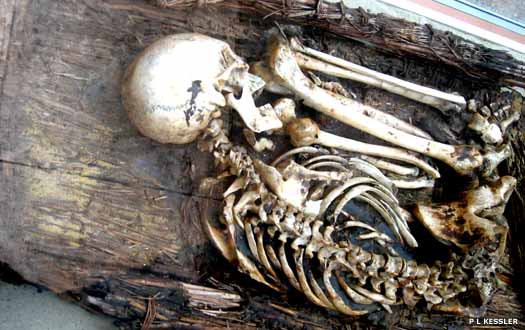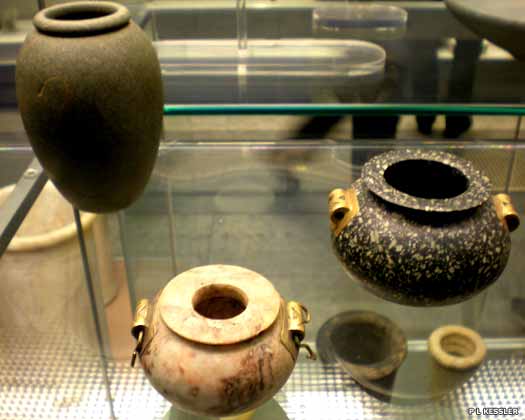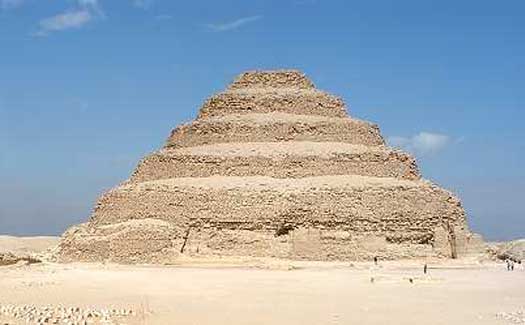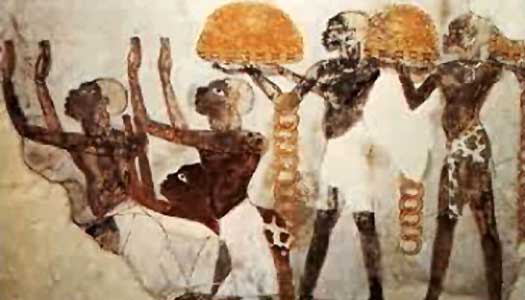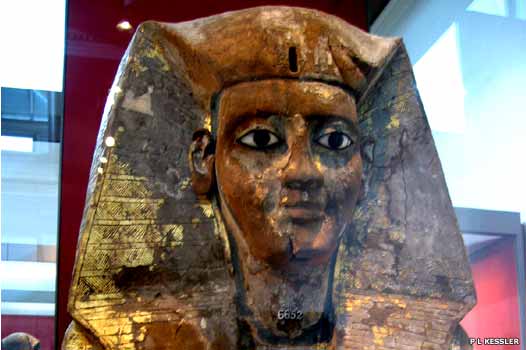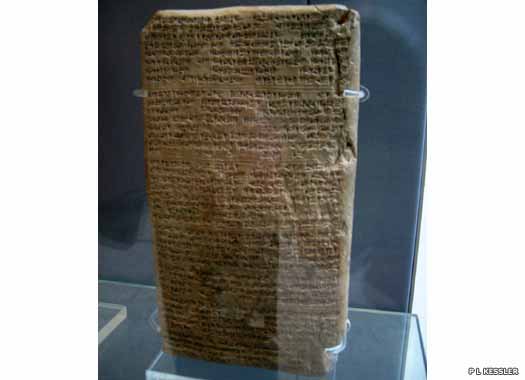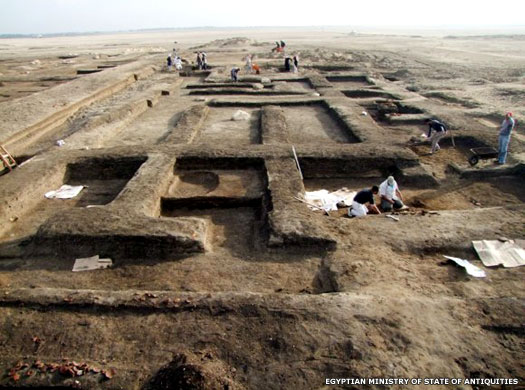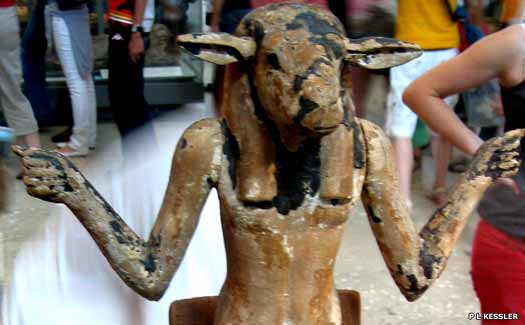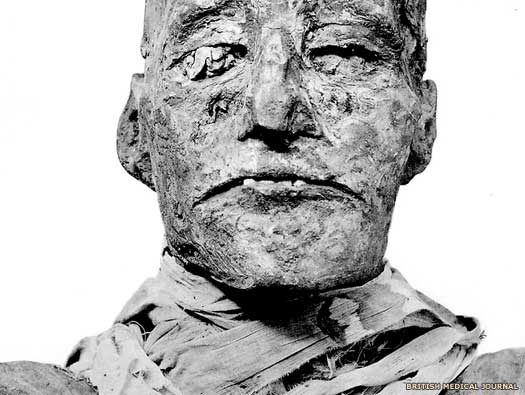
| ANCIENT EGYPT 34th Century - 30 BC :
Ancient Egypt was formed essentially of a narrow valley that was bordered on either side by extensive deserts. With the River Nile running through it like a ribbon, it depended on these waters for its very life and also for its transportation. The annual floods would ensure another year of food stocks, and occasional dry spells could spell famine and death. The river also connected the Mediterranean to the lands beyond Egypt, lands which were barely understood at first but which crystallised over time into Nubia and Ethiopia.
One of the oldest known civilisations in human history, the rulers of Egypt were known as pharaohs (meaning 'Great House'). They left their mark in countless records, including royal inscriptions, and in pyramids and tombs. Many early records from outside of Egypt are Greek in origin, so in many cases the Greek version of names are shown in parenthesis.
From around 9000 BC, the North African hunter-gatherer inhabitants of the fertile Nile Valley enjoyed the milder post-glacial conditions, domesticating animals and increasing in number. In the late sixth millennium BC farming villages appeared, as did rock art in some of the region's caves, and the following two millennia saw the gradual formation of small states.
After 4000 BC, thanks to the sudden desiccation of the grass plains of the Sahara and an influx of people towards the Nile, there was a substantial increase in population, and villages sizes increased accordingly. From around 3500 to 3000 BC there were great and very sudden advances in craftsmanship and technology, which culminated in the working of copper, stone mace heads, and ceramics. The first walled towns appeared at Naqada and Heirakonpolis (circa 3300 BC), and were associated with rich tombs, probably the resting places of the rulers of Upper Egypt (to the south). One of these rulers was the first to unite the whole valley, from the first cataract near the Nubian Desert to the Mediterranean, as a single kingdom around 3400 or 3100 BC.
There are two main schools of thought regarding the dating of Egyptian dynasties. The earlier one was long used here as it was generally accepted, but a more recent (and increasingly accepted) version is now replacing that. There are also other, far more radical theories being proposed which either dramatically length or shorten the timescale shown here. None of them are entirely conclusive or are at all widely accepted.
Egypt's Archaic Period :
The archaic period includes the Early Dynastic Period, when Lower Egypt and Upper Egypt were ruled as separate kingdoms, and the First and Second Dynasties.
Highly interesting new research that was published in the Proceedings of the Royal Society in 2013 established what was possibly the most accurate timeline for early Egypt. Previous records had suggested that the pre-Dynastic period, a time in which early groups began to settle along the Nile and farm the land, began in 4000 BC. But the new analysis revealed this process to have started later, between 3700 or 3600 BC. By the thirty-second century, Egypt had transformed into two kingdoms, north and south, and these were quickly merged into one.
Around 3600 BC there was known to be a kingdom centred around Hierakonpolis in Upper Egypt. Archaeologists discovered one of Egypt's largest funerary complexes in the Kom al-Ahmar region, to the south of Luxor, which probably belonged to this kingdom. According to the experts, the city probably extended its influence northwards, defeating rival entities along the way, especially the smaller but still powerful rival centre in Lower Egypt. This was the process which eventually united the two early dynastic kingdoms in Egypt.
Early Dynastic (Lower Egypt) :
Lower Egypt, the area nearest the Mediterranean, was known as the Black Land, and consisted of the northern Nile and the Nile Delta. The following list is probably incomplete.
Tiu
Thesh
Hsekiu
New Dating c.3150 BC? :
Waznerc.
New Dating 3250 - 3125 BC :
Early Dynastic (Upper Egypt)
Upper Egypt was known as the Red Land, and consisted of the southern Nile and the deserts. An early centre of power was at Hierakonpolis, which may have produced the strongest kingdom in the Archaic Period. No names of rulers are known, unfortunately, but the kings here established a large necropolis to the south of Luxor. The following list is probably incomplete, as there are many more names which are of uncertain existence.
FeatureUpper Egypt was also the site of archaeological discoveries of some of the earliest-known purpose-built boats. These boats, buried for five millennia, are believed to date between the Archaic Period and the 3rd Dynasty. They are probably intended for the pharaoh in the afterlife, and all point towards the nearby Nile. These early boats are the ancestor of the later, grander solar boats which were designed for the same purpose.
New Dating c.3250 BC? :
Serket I : Oldest tomb at Umm el-Qa'ab had scorpion insignia.
New Dating c.3200 BC? :
Iry-Hor : Kingship uncertain.
New Dating c.3150 BC? :
Ka
New Dating c.3150 BC? :
Serqet II (King Scorpion) : Very uncertain. May be same as Menes or Narmer.
New Dating c.3125 - 2890 BC :
First
(Thinite) Dynasty (Egypt) :
FeatureThe Old Kingdom was a theocratic state dominated by a divine king. Belief in life after death was a fundamental religious tenet, and both kings and courtiers built increasingly elaborate tombs to reflect this belief. Mummification was already being practised, from perhaps 5000 BC in its most basic sense.
Egypt was governed by ministers who were answerable to the pharaoh and headed by the vizier, responsible for administration, justice and taxation. The country was divided into provinces (nomes), each ruled by a provincial governor, who became increasingly independent of central control. (Many early records from outside of Egypt are Greek in origin, so in many cases the Greek version of names are shown in parenthesis.)
New research that was published in the Proceedings of the Royal Society in 2013 established what was possibly the most accurate timeline for early Egypt, placing the accession of its first unified ruler at about 3100 BC. The formation of Egypt was unique in the ancient world in that it was a territorial state of the modern type which straight away formed borders. Until now, the chronology of Egypt's earliest days had been based on rough estimates, but with no written records from this very early period, the timeline was based on the evolving styles of ceramics unearthed from human burial sites. The 2013 research used radiocarbon dating of excavated hair, bones and plants alongside established archaeological evidence and computer models to pinpoint when the ancient state came into existence.
New Dating c.3125 BC and Old Dating c.3400 BC :
Menes / Meni (Min) : United North & South kingdoms.
New Dating c.3125 BC :
According to Herodotus, Memphis is founded as the capital of Egypt by Menes. According to other sources the capital is at the city of 'This' near Abydos, which itself dates back to prehistory. Perhaps the confusion arises from the fact that Menes has tombs at both Saqqara, close to Memphis in Lower Egypt, and at Abydos in Upper Egypt.
Coffins started to be used in Egyptian graves from about 3000 BC, and could be made of wood, basketry or pottery. This First Dynasty basketwork coffin comes from Tarkhan
Old Dating c.3300 BC :
Narmer : Important in the unification of Egypt.
The Narmer Palette shows the pharaoh Narmer wielding the unified symbols of both Upper and Lower Egypt. Some theorise that Narmer and Menes are in fact the same person; others that Menes had inherited an already-unified kingdom from Narmer; while others suggest that Menes had completed a process of unification which Narmer had begun. The view that Narmer actually succeeded Menes seems to be an older one, and is used here.
New Dating c.3100 BC :
Aha / Hor-Aka : Son.
In 2013, a new timeline for the origin of ancient Egypt is established by scientists. A British team finds that the transformation from a land of disparate farmers into a state ruled by a king had been more rapid than was previously thought. Using radiocarbon dating and computer models, they believe the civilisation's first ruler - King Aha - comes to power around 3100 BC.
New Dating c.3000 BC :
The first evidence of Egyptian hieroglyphics - already very advanced in form - appears at this time.
Djer : Ruled a united Egypt. Reigned for 41 years.
Djer's reign of forty-one years is perhaps unfeasibly long for this time period, raising the possibility that he dies much sooner and the kingdom collapses, if only briefly. The king rules in name simply because no one else has replaced him, leading later generations to assume that he is alive for this entire period.
Djet / Wadj/Zet/Uadji (Uenephes)
Den (Dewen) : First to use the title 'King of Upper and Lower Egypt'.
Merneith : Female regent or queen.
Anedjib / Enezib / Andjyeb : Reigned for 10 years.
Semerkhet : Possible usurper. Reigned for 9 years.
New Dating 2916 - 2890 BC and Old Dating c.3200 BC :
Qa'a / Ka'a : Reigned for 26 years.
New Dating 2890 - 2686 BC :
Second
(Thinite) Dynasty (Egypt) :
Little is known about the start of the Second Dynasty. It is possible that Hotepsekhemwy reached office by marriage to a princess, so it isn't known if he was related to the old Thinite line of rulers or not. He is not thought to be the son of Qa'a, but could possibly be his son-in-law. He made offerings in memory of the man and was possibly responsible for Qa'a's funeral. Seals with the name of 'Hotepsekhemwy' have been found outside the tomb of Qa'a at Abydos. His tomb has been identified in Saqqara; the substructure has survived but there are no remains of a superstructure.
Many early records from outside of Egypt are Greek in origin, so in many cases the Greek version of names are shown in parenthesis.
New Dating 2890 - ? BC and Old Dating c.2915 BC :
Hotepsekhemwy (Boethos)
Raneb (Nebra) : Possibly reigned for 39 years.
Nynetjer : Reigned for 40 years.
Wneg : Reigned for 8 years.
Senedj : Reigned for 20 years.
Seth-Peribsen : Reigned 17 years. Possibly only ruled Upper Egypt.
While Sekhemi-Perenmaat seems to be fairly securely recognised as the predecessor of the final second dynasty pharaoh, Khasekhemui, Seth-Perinsen is much harder to pin down. It is likely that he ruled the southern half of Egypt only, while Perenmaat rules the northern half and succeeds to the rest upon Peribsen's death.
The vase on the left is of sedimentary stone and dates from the Second Dynasty, while the other two are stone vases with gold-covered handles, First or Second Dynasty Sekhemib-Perenmaat : Possibly only ruled Lower Egypt.
New Dating 2704 - 2686 BC :
Khasekhemui (Khasekhemwy) : Reigned for 18 years.
Egypt's Old Kingdom :
Egypt attained its first continuous peak of complexity in its civilisation and achievements with its administration centralised at Memphis, where Zoser established his court. The Old Kingdom is perhaps best known for the large number of pyramids which were constructed at this time as pharaonic burial places. For this reason, the Old Kingdom is frequently referred to as 'the Age of the Pyramids', and for much of its existence, it achieved a remarkable level of stability, not only for its ruling elite but for Egyptians in general.
FeatureThat pyramid culture, according to Dr Robert Lomas of the University of Bradford, could have developed as far away as Orkney to the north of the British Isles. He developed the theory that complex pyramid construction techniques were developed there more than a thousand years years before the Egyptians used similar ideas. He said skills used on the islands from 3800 BC were extremely sophisticated, perhaps spreading from there through Europe until they could be picked up by the Egyptians. To offset this theory, the Neolithic farmer migrations into the British Isles from around 4000 BC would have seen the arrival of people with an Anatolian heritage who had spent two thousand years in Iberia following their journey along the northern edge of the Mediterranean. It is much more likely that they brought with them some form of shared knowledge that eventually led to pyramid building both in Egypt and the Orkneys.
New Dating 2686 - 2613 BC :
Third
(Memphite) Dynasty (Egypt) :
Sanakhte's name means 'strong protection'. He presumably gained his position by marriage to a daughter of Khasekhemui, with rule even at this early period being passed down through the female line. (Many early records from outside of Egypt are Greek in origin, so in many cases the Greek version of names are shown in parenthesis.)
Memphis was the capital of the first province (nome) of Lower Egypt, and it became the kingdom's capital, strategically situated as it was at the junction of the Nile Valley and the Delta. Memphis remained a major administrative centre, if not always the capital, until it was supplanted by Cairo in the seventh century AD. Its original Egyptian name was Ineb Hedj (The White Walls), while the name 'Memphis' was a Greek deformation of the Egyptian name of Pepi I's (Six Dynasty) pyramid, Men-nefer.
(Additional information on the incorrect dating of the Old Kingdom by Sean B.)
New Dating 2686 - 2668 BC :
Sanakhte / Nebka (Mesochris) : Egyptian (Greek) versions of same name.
New Dating 2668 - 2649 BC :
Zoser (Djoser) : Heralded the age of pyramids.
New Dating c.2650 BC :
The first Egyptian stepped pyramid - the sixty-two metre-high stone-stepped Pyramid of Zoser - is built at the Saqqara necropolis opposite Memphis. The chief architect for the project is Imhotep (or variously Immutef, Ii-em-Hotep, or Imuthes, the latter being a Greek variation). Is this first stepped pyramid to be aligned to the north-finding stars in the way of later versions.
The Zoser pyramid - built during the twenty-seventh century BC for the burial of Zoser (or Djoser) - shows the development towards the later Great Pyramid of Khufu New Dating 2649 - 2643 BC :
Sekhemkhet
One school of thought on the dating of the early Egyptians and the Israelites suggests that evidence proves that the Third Dynasty (and therefore the rest of the Old Kingdom) is dated too early, with Menes more accurately being placed about 2300 BC. That would allowSekhemkhet to be claimed as Joseph of the Israelites, vizier to the pharaoh, Zoser. However, even this dating places Sekhemkhet about six hundred years before Abraham exists, let alone his descendant, Moses.
New Dating 2643 - 2637 BC :
Khaba
New Dating 2637 - 2613 BC :
Huni
New Dating 2613 - 2498 BC :
Fourth
(Memphite) Dynasty (Egypt)
The fourth dynasty saw the flowering of pyramid construction. Central administration continued to be based at Memphis. Trading links were established with the Canaanite trading city of Gebal (if they hadn't already been established as early as 3000 BC).
Many early records from outside of Egypt are Greek in origin, so in many cases the Greek version of names are shown in parenthesis.
New Dating 2613 - 2589 BC and Old Dating c.2920 BC :
Sneferu (Snefru)
New Dating 2589? BC :
Son? Mentioned by inference: Khufu is 'third to rule'.
New Dating 2589 - 2566 BC and Old Dating 2900 - 2877 BC :
Khufu (Cheops) : Brother? One of the earliest great pharaohs.
c.2550 BC :
Construction of the one hundred and forty-seven-metre-high Great Pyramid of Khufu is completed at Giza. However, the pyramid contains several chambers and shafts, some of which are still reluctant to give up their secrets even in the twenty-first century AD.
The Sphinx is generally dated to the same period, intended to guard the pyramid. However one theory claims that there should be two sphinxes, while another claims that the single Sphinx is much older, and only now is its head reshaped to resemble a pharaoh.
At this time the desiccation of the Sahara region is increasing.
New Dating 2566 - 2558 BC :
Dedefrê / Djedefra (Radjedef) : Son.
New Dating 2558 - 2532 BC :
Khafrê (Chephren) : Son of Snefru. Built 2nd Great Pyramid.
New Dating 2558 - 2532 BC :
Khafrê (Chephren) : Son of Snefru. Built 2nd Great Pyramid.
Bikheris : Mentioned by the historian Manetho.
New Dating 2532 - 2503 BC and Old Dating 2800 BC :
Menkure (Mycerinus) : Built 3rd (Lesser) Great Pyramid.
New Dating c.2500 BC :
Egyptians begin to move into Nubia, importing their culture and setting up trading centres. This would seem to be the same land as that of the kingdom of Punt or Put. Punt is sometimes described as being Libya in Greek texts, but 'Libya' could be used to describe a broad sweep of the North African territories. Instead, Punt appears to lie to the south-east of Egypt, making either Nubia or the Arabian peninsula more likely as its location.
New Dating 2503 - 2498 BC :
Shepseskaf : Built 3rd (Lesser) Great Pyramid.
Thampthis : Mentioned by the historian Manetho.
New Dating 2498 - 2345 BC :
Fifth
(Memphite) Dynasty (Egypt) :
FeatureThe circumstances behind the founding of this dynasty seem to be completely unknown at present, but considering Userkaf's grandfather, he was probably from a secondary line of the pharaonic royal family. Userkaf started the tradition of building sun temples at Abu Sir, just south of Cairo. The resultant complex there is very popular during the dynasty's existence but falls into disrepair afterwards, only to be revived again under the Twenty-Sixth dynasty.
New Dating 2498 - 2491 BC :
Userkaf / Shepseskaf (Weserkef) : Grandson of Khafrê.
New Dating 2491 - 2477 BC :
Sahure : Probable son.
New Dating 2477 - 2467 BC :
Nefererkere Kakai : Probable brother.
New Dating 2467 - 2460 BC :
Shepseskare Isi
New Dating 2460 - 2453 BC :
Neferefre
New Dating 2453 - 2422 BC :
Nyuserre Ini
New Dating 2422 - 2414 BC :
Menkauhor Kaiu
New Dating 2414 - 2375 BC :
Djedkare Isesi
New Dating 2400 BC :
Royal power is in decline and the size of the pyramids decreases accordingly. Regional governors have become so powerful that they treat their provinces as petty kingdoms, and are buried in impressive rock-cut tombs at provincial centres up and down the Nile Valley.
New Dating 2375 - 2345 BC :
Unas
New Dating 2345 - 2181 BC :
Sixth
(Memphite) Dynasty (Egypt) :
This dynasty was founded by Teti, who married Iput, commonly believed to be the daughter of Unas of the fifth dynasty. Under it, there was trade with the relatively newly-established city states of Syria, including Ebla. Towards its end the dynasty descended into uncertainty and decline, as natural disaster combined with social disorder to end the Old Kingdom Period in Egypt.
New Dating 2345 - 2333 BC :
Teti
New Dating 2333 - 2332 BC :
Userkere (Weserkere)
New Dating 2332 - 2283 BC and Old Dating 2590 - 2570 BC :
Pheops (Pepi) I Merire
The wives of Pheops I are both named Ankh-sn-Pepi (Ankhesenpepi I and II, otherwise known as Ankhesenmeryre), and the two are sisters. Ankhesenpepi II's son is Pheops II, who reigns following the death of his half-brother. He may serve as supreme king while four successive sub-kings also govern the country, although this is unclear. Coming to the throne at a young age, he may also have his mother as regent for the start of his reign. Upon her death, she is buried in a pyramid at Saqqara.
New Dating 2283 - 2278 BC :
Merenre Nemtyemsaf I : Son by Ankhesenpepi I.
New Dating 2278 - 2184 BC and Old Dating 2566 - ? BC :
Pheops (Pepi) II Neferkere : Half-brother. Possibly reigned while the next 4 ruled.
New Dating 2200 - 2199 BC :
Neferka : Child. Co-regent.
New Dating 2197 - 2193 BC :
Nefer : Reigned for 2 years, 1 month and a day.
New Dating 2193 - 2176 BC :
Aba : Highly unlikely.
? : Unknown and uncertain pharaoh.
New Dating 2184 BC :
Merenre Nemtyemsaf II : Uncertain pharaoh.
New Dating 2184 - 2181 BC :
Nitiqret : Uncertain queen.
Egypt's First Intermediate Period :
The First Intermediate Period, beginning around 2200 BC, was Egypt's Dark Age, heralding a period of disunity and relative cultural decline. Traditional thinking says that the Old Kingdom rapidly collapsed after the death of Pheops II. He had reigned for 94 years, longer than any monarch in history, and he died aged a hundred. The latter years of his reign were marked by inefficiency due to his advanced age, and when he was gone the Union of the Two Kingdoms fell apart amid bitter in-fighting to select his successor. Regional leaders had to cope with the resulting famine.
In fact, there seems to have been a general climate-induced collapse around this time in the Near East, as Sumerian cities were also affected in the twenty-second century BC. A much more all-encompassing theory about the collapse of the Old Kingdom can be tied to this same extreme climate change event, and the effect it had on Egypt. The event was triggered by the onset of a mini ice age (known to occur in Europe every 1,500 years or so, and lasting for about 200 years). Due to reduced rainfall at the Nile's headwaters, the river suffered a series of low or completely failed annual floods which destroyed Egypt's crop supply. Sandstorms fed by the increased desiccation of formerly green or semi-green areas on the edge of the Sahara smothered the land.
The large inland lake known today as Birket Qarun was linked during this period to the Nile by a tributary. When the Nile flood arrived each year, the lake would greatly expand. During the First Intermediate, the lake did not expand. In fact, the lack of sediments for this period show that it died up completely, and all of the previous Old Kingdom sediments were blown away by the winds and the scouring desert sands. This is the only time in its entire history that the lake has dried up completely.
Communities in the Nile Delta were reduced to absolute poverty, not knowing where their next meal would come from. Some were reduced to fighting amongst themselves for the smallest scraps, including corpses, carrion, dogs, and waste. One account, on the walls of the tomb of a local governor named Ankhtifi, relates that people were even eating their children in their desperation to survive. A first-hand account by a doctor who was in Old Cairo in AD 1200 describes much the same thing for another, much more brief famine, supporting the evidence for this earlier famine.
(Additional information from the BBC documentary series, Ancient Apocalypse: Death on the Nile, first broadcast 26 July 2001.)
New Dating 2181 - 2160 BC :
Seventh
& Eighth (Memphite) Dynasties (Egypt) :
A time of confusion and collapse, records are sparse and details unclear. The Nile floods, always erratic, now proved to be consistently low, causing drought and turmoil. Half a century of disastrous famine caused organised society to fall apart and there followed a period in which provincial officials engaged in power struggles and twenty short-lived pharaohs ruled in a state of feudal strife that lasted for a century. (This table is based on the Abydos Table from the Temple of Seti I and is not conclusive.)
Neferkara I :
The combined seventh and eight dynasties survive as little more than a series of names, and not even all of those are accepted by all scholars as valid pharaohs. After perhaps twenty years of famine and chaos, Egypt is still suffering vastly reduced Nile floods and its people are starving. There seems to be no end in sight of their suffering, and it will be a further century and-a-half before the situation recovers appreciably.
This impression of a sandstorm (by Johann Jakob Frey, 1813-1865) around the Sphinx conveys something of its oppressiveness, but this is a brief, single event that cannot be compared to the two centuries of suffering experience in Egypt at this time Neferkara Nebi
Djedkara Shemai
Neferkara Khendu
Merenhor : Not accepted by all scholars.
Neferkamin Senefer
kaNikara
Neferkara Tereru
Neferkahor
Neferkara Pepyseneb
Neferkamin Anu
Qakare Ibi
Neferkara II
Neferkawhor Khuwihap
Neferirkara
New Dating 2160 - 2130 BC :
Ninth
(Herakleopolitan) Dynasty (Egypt) :
Around 2160 BC, a new line of pharaohs tried to reunite Lower Egypt from their capital at Herakleopolis Magna, the twentieth nome (province) of Egypt. A rival line based at Thebes was reuniting Upper Egypt and a clash between the two rival dynasties was inevitable.
New Dating 2160 - ? BC and Old Dating 2445 - ? BC :
Meryibre Khety (Achthoes I) : Nomarch (provincial ruler). Founded the dynasty.
Meribre Khety II
Neferkare III
Nebkaure (Acthoes II)
Setut
Wakhare Khety I / Achthoës
Merykare
Wankhare Khety II
Menethoupe I
Wankhare Khety III
Khety II
New Dating - 2130 BC :
Daughter.
Merikare's daughter.
New Dating 2130 - 2040 BC :
Tenth
(Herakleopolitan) Dynasty (Egypt) :
The Tenth Dynasty continued at Herakleopolis Magna, while Egypt remained fragmented. Only four names are known here, although there is the possibility that more actually reigned. The rulers of Thebes quickly became major rivals for power.
New Dating 2130 - ? BC :
Meryhathor
Neferkare IV
Wankare (Acthoes III)
New Dating - 2040 BC :
Merykare
Egypt's Middle Kingdom :
The Middle Kingdom can be noted for the expansion of trade outside of the kingdom that occurred during this time, including maintaining a presence along the Mediterranean coast, in Canaanite cities such as Gebal and Syrian cities such as Carchemish. This opening of trade eventually led to the downfall of the Middle Kingdom, induced by an invasion by the Hyksos.
FeatureHowever, it was around this time, 2000 BC, that something dramatic was taking place on Egypt's western border. Over a very short time scale - possibly as short as three hundred years - the Sahara Desert went from grassland and low shrubs to arid desert. Summer temperatures increased rapidly and rainfall almost ceased. The loss of agricultural land to the desert may be one reason why the Middle Kingdom flourished along the banks of the Nile, and builds a presence along the Mediterranean coast to its north.
New Dating 2040 - 1991 BC :
Eleventh
(Theban) Dynasty (Egypt) :
The Eleventh Dynasty was based at Thebes (the Greek version of the Egyptian word niwt-rst, 'Southern City') and began as a rival to the Herakleopolitan Tenth Dynasty. Around 2055 BC, Mentuhotep II defeated the Herakleopolitan pharaohs, reunited the Two Lands, founded the Eleventh Dynasty and ruled as Mentuhotep II, the first pharaoh of the Middle Kingdom.
New Dating 2134 - ? BC :
Mentuhotep I : Founded the dynasty in Thebes.
New Dating ? - 2118 BC :
Sehertawy Intef I (the Great) : Son of Iku. Nomarch of Thebes.
New Dating 2118 - 2069 BC :
Wahankh Intef II : Claimed to rule over all Egypt.
Intef II is the first of the dynasty to claim to rule over the whole of Egypt, which brings the Thebans into conflict with the rulers of Herakleopolis Magna. Intef undertakes several campaigns northwards, and captures the important nome (province) of Abydos.
New Dating 2069 - 2061 BC :
Nakhtnebtepnefer Intef III
New Dating 2061 - 2010 BC :
Nebheteprac Mentuhotep II : Reunited Egypt.
The reunification of Egypt is effected under Mentuhotep II. Nubia is occupied as far as the Second Cataract.
New Dating 2010 - 1998 BC :
New Dating 1998 - 1991 BC :
Nebtawyra Mentuhotep IV : Died mysteriously.
New Dating 1991 - 1802 BC :
Twelfth
(Theban) Dynasty (Egypt) :
The reign of the last king of the Eleventh Dynasty is something of a mystery. Contemporary records refer to 'seven empty years' following the death of Mentuhotep III, which correspond to the reign of Nebtawyra Mentuhotep IV. Modern scholars identify his vizier, Amenemhat, with Amenemhat I as part of a theory that Amenemhat became king during a palace coup.
The dynasty founded a new capital at El-Lisht. Middle Kingdom rulers were buried in desert-edged pyramids nearby.
New Dating 1991 - 1962 BC and Old Dating 1991 - 1970 BC :
Amenemhet I (Ammenemes) : Vizier of the previous pharaoh.
New Dating 1971 - 1926 BC and Old Dating 1970 - 1938 BC :
Senusret I (Sesostris) : Son.
Senusret I officially establishes the southern border of Egypt 'in order to prevent' any people from the Nubian kingdom of Kerma 'crossing the frontier, by water or by land unless for trading or other approved purposes'.
New Dating 1926 - 1895 BC and Old Dating 1938 - 1903 BC :
Amenemhet II : Son.
New Dating 1897 - 1878 BC and Old Dating 1903 - 1887 BC :
Senusret II : Son.
New Dating 1878 - 1860 BC and Old Dating 1887 - 1849 BC :
Senusret III : Son. Most powerful of the Middle Kingdom pharaohs.
New Dating c.1850 BC :
The heavily policed Egyptian border is used as a launch pad for a series of raids under Senusret III against Kerma in Nubia. A canal is built around the Nile's first great series of rapids (the First Cataract) near Aswan to facilitate troop movements. The pharaoh launches a series of invasions and boasts of his exploits in the kingdom of Kerma.
New Dating 1860 - 1815 BC and Old Dating 1849 - 1801 BC :
Amenemhet III (Moarith) : Son.
New Dating c.1800 BC :
The horse is introduced into Egypt.
This Egyptian wall painting depicts Nubians bringing offerings of gold around 1850 BC, at which time Pharaoh Senusret III was launching a series of raids against the Nubian kingdom of Kerma New Dating 1815 - 1807 BC and Old Dating 1801 - 1792 BC :
Amenemhet IV : Son. Had a co-regency for one year.
New Dating 1807 - 1803 BC and Old Dating 1792 - 1788 BC :
Sebeknefrure (Nefrusobek) : Queen. Applauded as a national heroine.
New Dating 1803 BC and Old Dating 1788 BC :
The Middle Kingdom falls.
Egypt's Second Intermediate Period :
The Second Intermediate Period is best known as the point at which the Hyksos made their appearance in Egypt, whose reign comprised the Fifteenth and Sixteenth Dynasties. Seventy pharaohs ruled in a disrupted Egypt during this period, and for much of that time, they paid homage to the Hyksos. To the south, the Nubian kingdom was at its height, freed from interference by Egypt.
New Dating 1803 - 1600 BC :
Thirteenth
(Theban) Dynasty (Egypt) :
In later texts, this period is usually described as one of chaos and disorder. However, the period may have been more peaceful than was once thought since the central government in Itj-tawy near the Faiyum was sustained during most of the dynasty and the country remained relatively stable. However, the pharaohs were unable to prevent a break-away dynasty forming in the north.
Unfortunately it is difficult to ascertain an accurate chronology for this as there are few monuments dating from the period. Many of the kings' names are only known from an odd fragmentary inscription or from scarabs.
New Dating 1803 - 1799 BC :
Wegaf Khutawyre
Sekhemre : Brother.
New Dating 1795 - 1792 BC :
Ameny Intef IV (Amenemhet V) Sankhibre
New Dating ? - 1790 BC :
Sehetepre I
ufni
Seankhibre
Semenkare
Sewadjkare
Nedjem : Reigned for 7 months.
Sobekhotep I
New Dating c.1775 BC :
Renseneb : Reigned for 4 months.
New Dating c.1775? BC :
Hor Auyibre I
Sedjefakare : Reigned for 5-7 years. A well-attested ruler.
New Dating c.1767 BC :
Sobekhotep II (Amenmehet VI) Sekhemre Khutawy
New Dating c.1765 BC :
Khendjer Userkare : Reigned at least 4 years and 3 months.
Imyremeshaw
Antef V
New Dating c.1755 BC :
Sobekhotep III Sekhemre Sewadjtawy : Reigned for 4 years and 2 months.
New Dating 1751 - 1740 BC :
Neferhotep I Khasekhemre : Reigned for 11 years.
New Dating 1740 - 1730 BC :
Sobekhotep IV Khaneferre : Reigned for 10 or 11 years.
Old Dating 1720 BC :
The Hyksos make their first appearance during the reign of Sobekhotep IV, and around now they take control of the town of Avaris (the modern Tell ed-Dab'a / Khata'na).
New Dating c.1730 BC :
New Dating c.1725 - 1714 BC :
Wahibre Ibiau : Reigned 10 years and 8 months.
New Dating c.1714 - 1691 BC :
Ay Merneferre : Reigned 23 years and 8 months.
Merhetepre Ini : Reigned 2 years and 2 months.
Neferhotep II Sekhemre Sankhtawy : Precise dates unknown.
Mersekhemre Ined
Sewadjkare Hori
The position of the following kings is uncertain.
New Dating c.1654 BC :
Dudimose I
The Hyksos, led by Salitis, the founder of the Fifteenth Dynasty, overrun Egypt during the reign of Dudimose I.
Dudimose II
Senebmiu
Mentuhotep V
Senaayeb
New Dating c.1705 - 1690 BC :
Fourteenth Dynasty (Egypt) :
The provincial ruling family in Xois (Avaris), located in the marshes of the western Delta, broke away from the central authority to form the Fourteenth Dynasty. As a result, some dates overlap with those of the preceding dynasty. The Turin King List provides an additional 25 names, some fragmentary, and no dates. None are confirmed elsewhere, and all are of very dubious provenance. The dynasty was a very-short-lived one, being swiftly conquered by the Hyksos.
New Dating c.1705 BC :
Nehesy Khakherewre
New Dating c.1704 BC :
Nebefawre Sehebre
New Dating c.1699 BC :
Merdjefare Sewadjkare
New Dating c.1694 BC :
Nebdjefare
Webenre
? : Unknown pharaoh.
--djefare
New Dating c.1690 BC :
--webenre
New Dating c.1705 - 1534 BC :
Fifteenth
(Hyksos/Shepherd Kings) Dynasty (Egypt) :
The Hyksos, Semitic Sea Peoples who based themselves at the Nile Delta, made their capital at Avaris, the captured Fourteenth Dynasty capital. They ruled Lower Egypt directly, and exacted tribute from Upper Egypt, treating it as a subject satellite state. While Hyksos was formerly taken to mean 'shepherd king', modern thinking translates it as 'foreign king', and the Hykos are usually accepted as being refugees from Palestine, although Edom has also been claimed for the source.
It is possible that the Hyksos were driven to invade Egypt by the same famine in the Near East which caused the Israelites to migrate towards Egypt. Hurrians were also beginning to campaign into Syria and the Levant and may have pushed refugees southwards. At the same time as Memphis fell to the Hyksos, the native Thebans set up the rival Seventeenth Dynasty which fought to free Egypt.
An interesting discovery from the more recent post-communist era archaeology in China is the realisation that much of the nation's Bronze Age technology came from regions outside China. Bronze that arrived in China originated in the Babylonia-dominated Near East or ancient Egypt. Some of the wilder theories have put this down to an epic migration from Egypt to China, seemingly during the Hyksos period when long-distance seaborne travel was a definite possibility, although the distances involved in this case may have been far too great. A more prosaic consensus is that bronze was transmitted into China from Central Asia by a slow process of cultural exchange (trade, tribute, dowry) across the northern frontier, mediated by Eurasian steppe pastoralists who had contacts with indigenous groups in both regions. However, intriguingly, Sima Qian in his first century historiography, the Records of the Grand Historian, wrote in his description of the topography of the Xia empire, 'northwards the stream is divided and becomes the nine rivers. Reunited, it forms the opposing river and flows into the sea'. This was not a description of the Yellow River, which runs from east to west. The world's only great river to flow south to north is the Nile, with the 'nine rivers' being the Nile delta where it meets the Mediterranean. So far, no conclusive explanation has been provided for this.
(Additional information by Edward Dawson, and from External Link: Does Chinese Civilisation Come From Ancient Egypt?)
New Dating c.1705 - 1685 BC :
Salitis : Reigned for 20 years.
Sakir-Har : Named as an early king but position uncertain.
New Dating c.1674 - 1671 BC :
Sheshi : Reigned for either 3 or 1 years.
Yakubher
New Dating c.1620 BC :
Khyan : Reigned 30-40 years.
New Dating c.1580 - 1540 BC :
Apepi I
New Dating c.1550 - 1540 BC :
Apepi II? : May be the same man as Apepi I.
New Dating c.1540 - 1534 BC :
Khamudi : Obscure.
New Dating c.1663 - 1555 BC :
Sixteenth
(Theban) Dynasty (Egypt) :
This Theban dynasty was a local group based on the north coast of the Sinai (Pelusium), and cover a period of time when Egypt was split into a set of small Hyksos-ruled kingdoms. The rulers were contemporary with the Fifteenth Dynasty.
They are known mainly from their entries in the Turin King List, and are mostly unknown elsewhere. Dates and in some cases, order of reign, are also unknown. It s unclear how the names listed in green fit in with the rest of the list, except that all but the last reigned before Bebankh, as he is mentioned in both lists.
Anat-her
User-anat
Semqen
Djehuty (Sekhemresementawy) :Reigned for 3 years. May be the same as Semqen.
Zaket
Wasa
Qar
Pepi III
Sobekhotep VIII (Sekhemresewosertawy) :Reigned for 16 years.
Neferhotep III (Sekhemresankhtawy) : Reigned for 1 year.
Mentuhotepi (Sankhenra) : Reigned for 1 year.
Nebiryraw I (Sewadjenra) : Reigned for 26 years.
Nebiryraw II : Reigned for 3 months?
? (Semenra) : Reigned before Bebankh for 1 year?
Bebankh / Bebiankh (Sewoserenra) : Reigned for 12 years.
? (Sekhemreshedwaset) : Reigned after Bebankh for 3 months?
Nebmaatre
Nikare II
Aahotepre
Nubankhre
Nubuserre
Khauserre
Khamure
Jacob-Baal
Yakbam/Sekkhaenre? : Yakbam is an Amorite name.
Yoam
Amu
New Dating 1650 - 1550 BC :
Seventeenth
(Theban) Dynasty (Egypt) :
At around the time Memphis fell to the Hyksos, the native Egyptian ruling house in Thebes declared its independence and set itself up as the Seventeenth Dynasty. This dynasty eventually drove the Hyksos out of Egypt. The last two pharaohs of the dynasty opposed the Hyksos rule over Egypt and initiated a war that would rid Egypt of the Hyksos kings and began a period of unified rule which is known as the New Kingdom.
Rahotep Sekhemrewahkhaw
Intef V the Elder : Reigned for 3 years.
Sobekemsaf I
Sekhemreshedtawy
The Theban kings of the Seventeenth Dynasty locate their tombs in part of the Theban necropolis now known as Dra Abu el-Naga. They incorporate small pyramids in their building. Though the position of some tombs is known by the early nineteenth century AD, they are subsequently lost.
A sarcophagus from the Theban necropolis - known today as Dra Abu el-Naga - which was located on the west bank of the Nile opposite the city of Thebes in Upper Egypt Antef VI Sekhemrewepmaat
Antef VII Nebkheperre
Intef VIII Sekhemreherhermaat
Sobekemsaf II Sekhemrewadjkhaw : Reigned for 7 years.Thuty Reigned for 1 year.
Mentuhotep VI : Reigned for 1 year.
Nebiryerawet I : Reigned for 6 years.
Nebiryerawet II
Semenmedjatre
Seuserenre : Reigned for 12 years.
Shedwast
Intef VII
New Dating 1559 - 1558 BC :
Tao I the Elder Senakhtenre : Reigned for 1 year.
New Dating 1558 - 1554 BC :
Tao II the Brave Seqenenre : Reigned for 4 years.
New Dating 1554 - 1549 BC :
Kamose : Second son. Reigned for 5 years.
Old Dating fl 1580 BC :
Apophis of Avaris : Position unclear, but reigned at end of the dynasty.
Old Dating 1580 BC :
Egypt is freed from Hyksos rule by Kamose. Nubia is regained.
Egypt's New Kingdom :
FeatureWith the Hyksos thrown out of Egypt and the country reunited under native rule, the descendants of the Seventeenth Dynasty pharaohs formed the Eighteenth Dynasty. Quite probably as a result of the foreign rule of the Hyksos during the Second Intermediate Period, the New Kingdom saw Egypt attempt to create a buffer between the Levant and Egypt through military dominance abroad, creating Egypt's greatest territorial gains. It expanded far into Nubia in the south, and held wide territories in the Near East. Egyptian armies fought against Hittite armies for control of ancient Syria. Egypt also began to construct a chain of impressive forts, part of the militarisation of the Sinai. There would be no repeat of the Hyksos invasion while Egypt was capable of ensuring that fact.
New Dating 1550 - 1292 BC :
Eighteenth
(Diospolite) Dynasty (Egypt) :
The Eighteenth Dynasty had its capital at Thebes, although much of the administration probably remained at Memphis. The dynasty contained some of Egypt's most famous pharaohs including Ahmose I, Hapshepsut, Thutmose III, Amenhotep III, Akhenaten and Tutankhamun. Queen Hatshepsut concentrated on expanding Egypt's external trade, sending a commercial expedition to the land of Punt. Thutmose III ('the Napoleon of Egypt') expanded Egypt's army and wielded it with great success, militarising the eastern border and ensuring Egypt was properly defended.
(Additional information from The Amarna Letters, William L Moran, 1992, from The Complete Royal Families of Ancient Egypt, Aidan Dodson & Dyan Hilton, from Studies in the Reign of Amenophis II, Peter der Manuelian, and from the Egypt Exploration Society.)
New Dating 1550 - 1525 BC and Old Dating 1580 - 1557 BC :
Amasis (Ahmosi I) : Son of Kamose.
New Kingdom pharaohs begin the practice of burial in rock-cut tombs in the Valley of the Kings. They also immediately take control of the Canaanite city of Hazor.
New Dating 1525 - 1504 BC and Old Dating 1557 - 1540 BC :
Amenhotep I : Son.
New Dating 1504 - 1492 BC and Old Dating 1540 - 1505 BC :
Tuthmosis I (Thotmes) : Son. Re-conquered Nubia.
With the resurgence in Egyptian power, attention is turned again towards Nubia, where locals had created their own state or states during the Egyptian Intermediate Period, and now openly rebel when Tuthmosis gains the throne. A campaign south sees Nubia defeated and Egypt resumes control there. A swift campaign through Canaan and Syria follows in the pharaoh's second year.
New Dating 1492 - 1479 BC and Old Dating 1505 - 1501 BC :
Tuthmosis II (Thotmes) : Son. Died aged 24.
New Dating 1479 - 1458 BC and Old Dating 1501 - 1479 BC :
Hatshepsut : Regent and queen. Reasons for death unknown.
New Dating 1477 BC and Old Dating 1503 BC :
Following the sudden, and unexpected early death of Tuthmosis II, Hatshepsut, the daughter of Tuthmosis I and half-sister and wife of the dead king, acts as regent to the infant Tuthmosis III for the first two years of her reign. He is the son of Tuthmosis II and a junior wife who is unsuitable to act as regent. In 1503 Hatshepsut declares herself pharaoh and reigns for twenty-two years in a 'Gloriana' reign equivalent to that of Elizabeth I's of England.
New Dating 1479 - 1425 BC and Old Dating 1501 - 1447 BC :
Tuthmosis III (Thotmes) : Built first Egyptian empire.
New Dating 1478 BC :
Tuthmosis begins to permanently extend Egypt's influence in the Near East by conquering Palestine, and Canaan and entering into Syria on the southern borders of Mitanni.
New Dating 1473 BC :
Deir el-Medina is founded as a village of craftsmen responsible for Egyptian royal tombs.
New Dating 1458 BC and Old Dating 1479 BC :
Tuthmosis III gains the throne and immediately sets about removing any evidence of his stepmother's reign, bricking over her obelisks in the Luxor Temple and ordering images of her and cartouches bearing her name to be chiselled off walls.
Old Dating c.1400's BC :
Egypt is expanded to the Euphrates and the Fourth Cataract of the Nile.
New Dating 1453 BC :
Tuthmosis defeats Mitanni at the battle of Megiddo. Cyprus is also brought under Egyptian control. Egypt's territories in the Levant and Syria reach up to Amurru and include Canaan.
New Dating 1425 - 1400 BC and Old Dating 1447 - 1420 BC :
Amenhotep II : Son.
Oubensenou (also translated as Ouebsenou or Webensenu) is probably a son of Amenhotep II. His precise placing in the order of the pharaoh's children is unknown, and at least one scholar, Catharine H Roehrig, suggests that Tuthmosis III is actually his father. Dodson and Hilton state that he is a son of Amenhotep II who dies as a child and is buried with his father in tomb KV35. Peter der Manuelian refers to him as 'king's son and overseer of horses', and Betsy Bryan has suggested that he is born in the first five years of Amenhotep reign.
New Dating 1400 - 1388 BC and Old Dating 1420 - 1411 BC :
Tuthmosis (Thotmes) IV : Son. Marries daughter of the Mitanni king.
New Dating 1388 - 1352 BC and Old Dating 1411 - 1375 BC :
Amenhotep III : Son. Nicknamed 'the debauched'.
Old Dating c.1385 BC :
Amenhotep first marries the daughter of the Mitanni king Shuttarna II, the two kingdoms then being firm allies, and later marries the daughter of a successor, Tushratta.
The cuneiform tablet inscribed with a letter from Tushratta, king of Mitanni, to Pharaoh Amenhotep III, covers various subjects such as the killing of the murderers of the Mitanni king's brother and a fight against the Hittites New Dating 1352 - 1334 BC and Old Dating 1375 - 1358 BC :
Amenhotep IV / Akhenaten : Son.
New Dating 1348 BC and Old Dating 1371 BC :
Akhenaten institutes monotheism in the fourth year of his reign with the sole worship of the sun god Aton. In the following year he founds a new capital at Amarna. Unfortunately Egypt is not yet ready to abandon its many gods and, following the pharaoh's death virtually all traces of this 'heretic' and his beautiful wife, Nefertiti, are erased from history.
During his period of rule from there the Amarna letters are written - diplomatic correspondence with Assur-Uballit I of Assyria, the Kassite rulers of Babylonia, plus Mitanni, the Hittites, Alashiya, Arzawa, and the city states of Syria and Canaan - which includes descriptions of the disruptive activities of the 'habiru'.
New Dating 1352 - 1339 BC and Old Dating 1375 - 1361 BC :
Nefertiti : Wife & co-regent.
New Dating 1334 - 1333 BC and Old Dating 1358 - 1357 BC :
Smenkhare (Sakere) : Son-in-law of Akhenaten (or Nefertiti renamed?).
New Dating 1333 - 1324 BC and Old Dating 1357 - 1352 BC :
Tutankhamun : Probable son of Akhenaten.
The eight year-old Tutankhamun's accession is probably handled by Ai, the priest and master of horse for Akhenaten. To ensure that no outside interests gain a foothold in what is now his power base, he chooses the boy pharaoh's elder sister to be the queen. However, Tutankhamun's comparatively brief reign is halted by a hunting accident and subsequent blood poisoning. No curse is attached to his tomb.
Following his untimely death, Ankhesenamen, his young wife, seemingly succeeds him, but his regent (and possibly her grandfather), Ai, cements his own position by marrying Ankhesenamen.
New Dating 1324 - 1320 BC and Old Dating 1351 - 1350 BC :
Ankhesenamen / Kheperkheprure : Wife of Tutankhamun. Also known as Eje.
New Dating 1320 - 1316 BC and Old Dating 1350 - 1346 BC :
Ai : Regent to Tutankhamun & Ankhesenamen?
Old Dating c.1300 BC :
Egypt still conducts profitable trade with Damas in Syria, as witnessed by the building of a series of border fortresses as the former seeks to control the Sinai. The fortresses help to defend Egypt's trade route to Damas, which also passes through Edom and Moab at this time.
The archaeological discovery of the Egyptian fort of Tell Habua (ancient Tharu, built around 1000 BC) near the Suez Canal underlined Egypt's policy of maintaining border fortresses on its eastern flank New Dating 1316 - 1292 BC and Old Dating 1346 - 1315 BC :
Djeserkheperure Horemheb : Former C-in-C of Army (this is disputed).
New Dating 1292 - 1186 BC :
Nineteenth
(Diospolite) Dynasty (Egypt) :
Djeserkheperure Horemheb was the last pharaoh of the Eighteenth Dynasty. After seizing back his position of designated crown prince from the 'usurper', Ai, and because he had no heir of his own, he appointed his vizier, Paramesse as his chosen successor before his death. Paramesse employed the name Ramses I upon assuming power. The Nineteenth Dynasty set about erasing the name of Tutankhamun from history.
However, they did continue to use the Valley of the Kings for royal burials. One tomb was dug out just five metres away from Tutankhamun's tomb (probably not the best way of inducing complete forgetfulness of the boy pharaoh) and seven coffins were placed there, one of which contained a garland which survived for three thousand years to be discovered by archaeologists.
(Additional information from the NOVA/PBS documentary series, The Bible's Buried Secrets, first broadcast 18 November 2008.)
New Dating 1292 - 1290 BC and Old Dating 1315 - 1314 BC :
Ramses I : Army general.
New Dating 1290 - 1279 BC and Old Dating 1313 - 1292 BC :
Seti I : Son.
New Dating 1279 - 1213 BC and Old Dating 1292 - 1225 BC :
Ramses II (the Great) : Son. Co-regent 1292.
New Dating 1275 BC and Old Dating 1286/1258 BC :
Ramses
reaches a stalemate with the Hittites at the Battle of Kadesh, after
which the earliest known peace treaty is signed in 1258 BC. Ramses
limits his control to southern Palestine, where he draws a firm
and fortified boundary. A statue erected at Luxor by Ramses II lists
Mu'ab as one of a series of states conquered by him during a campaign,
usually assumed to be Moab.
Ramses II is known during his reign as the oppressor of the Israelites, and he may be the unnamed pharaoh of the Old Testament, but whether the well-known story of the Israelite exodus from Egypt occurs at this point in time is still unproven and highly debatable. Egyptian control over the Levant (including Canaan) gradually slips away despite large chariot-driven forces and supporting foot soldiers. Instead, Ramses constructs a series of forts close to the Egyptian border.
Wooden figure of a jackal-headed deity from the Valley of the Kings, Nineteenth or Twentieth Dynasty, representing either Anubis or Duamutef, one of the four sons of Horus New Dating 1213 - 1203 BC and Old Dating 1225 - 1215 BC :
Merneptah : Son.
1208 BC :
In his fifth year, Merneptah claims to successfully repel an attack by Libyans and an assortment of people from the north (including a detachment of the Lukka), whom he calls 'of the countries of the sea', or Sea Peoples. They try to enter Egypt by force, but also bring their families and cattle, clearly intending to stay.
In a brief addendum near the bottom of the stele which captures this glory (now exhibited in the Cairo Museum), Merneptah also mentions that Ashkelon, Gezer, and Yanoam (in the north Jordan Valley) have been captured and that Israel 'has been shorn. Its seed no longer exists'. The first two cities have probably already been captured by the invading Philistines and are therefore targets for 'rescue' by a civilised king. Israel, too, is the name given to a recently-arrived or formed group which would need to be brought to heel (although the claim that its seed no longer exists is mere boastfulness). This is the earliest definitive mention in history of a people named 'Israel'.
New Dating 1203 - 1200 BC :
Amenemses
c.1200 BC :
Egypt gains overlordship of Canaan, and perhaps the Israelites and Philistines, both of which are only just settling in the region.
New Dating 1200 - 1194 BC and Old Dating 1215 - 1212 BC :
Seti II
New Dating 1194 - 1188 BC and Old Dating 1215 - 1209 BC :
Siptak : Rival Regent.
New Dating 1188 - 1186 BC :
Tausret (Pielady) : Queen.
New Dating 1185 - 1075 BC :
Twentieth
(Diospolite) Dynasty (Egypt) :
As happened under the later Nineteenth Dynasty, this group struggled under the effects of the bickering between the heirs of Ramses III. However, at this time Egypt was also increasingly beset by a series of droughts, below-normal flooding levels of the Nile, famine, civil unrest and official corruption - all of which would limit the managerial abilities of any king. The kingdom declined, and with it, Egyptian influence outside its own borders.
The power of the last king, Ramses XI, grew so weak that in the south the High Priests of Amun at Thebes became the effective de facto rulers of Upper Egypt, while Smendes controlled Lower Egypt even before Ramses XI's death. Smendes would eventually found the Twenty-First dynasty at Tanis. In fact, the whole region, from Syria and the Levant, to the Hittites in Anatolia, and Assyria and Babylonia, was at this time in the grip of a dark age resulting from the general instability of circa 1200 BC, and a new people, the Aramaeans, were migrating into Mesopotamia and Syria, exacerbating the situation.
New Dating 1185 - 1183 BC and Old Dating 1198 BC :
Setnakhte
New Dating 1183 - 1152 BC and Old Dating 1198 - 1167 BC :
Ramses III : Son. Last great pharaoh. Murdered.
New Dating 1178 - 1175 BC and Old Dating 1193 - 1190 BC :
In his fifth year (1179 BC), Ramses fights off attacks from people from the north, almost certainly the Sea Peoples. In his eighth year (1176 BC), as well as defeating another attack, he provides an overview of the general collapse in the eastern Mediterranean in the face of attacks by the Sea Peoples. The twelfth year (1172 BC) sees another attack. However, Ramses may be claiming the victories of his predecessor, Merneptah, although his statements do highlight Egypt's loss of influence outside its own borders by this date. There is a possibility that these defeated Sea Peoples include the Philistines, the defeat forcing them to settle Canaan instead.
New Dating 1152 BC and Old Dating 1167 BC :
A plot to extract revenge is hatched by Tey (or Tiye), one of Ramses' wives, who has been overlooked for the position of principal wife when the pharaoh had chosen another wife, Isis. The plot results in the murder of Ramses and an armed uprising. Isis and her son, Ramses IV, defeat the uprising and the conspirators, including many senior figures, are sentenced to death. The eldest son of Tey, Pentawere, is the only one of Ramses' sons to join the uprising. He is tried and found guilty, and subsequently takes his own life.
Modern CT scanning techniques have revealed that Ramses has his throat slit to kill him, and the embalmers who mummify his body embed a Horus eye in the wound, a charm that is most probably intended to promote healing. Pentawere seems to have been strangled, possibly meaning that he has someone else end his life on his orders. The process of mummification has been perfected by this point, with fashion and cost even influencing the choice of materials to use.
The mummy of the last great pharaoh, Ramses III, revealed the fact that his throat had been slit to a width of seven centimetres, more then enough to kill him instantly New Dating 1152 - 1146 BC and Old Dating 1167 - 1161 BC :
Ramses IV : Son. Lost Philistia and part of Syria to Assyria.
New Dating 1146 - 1142 BC and Old Dating 1161 - 1157 BC :
Ramses V
Ramses VI
New Dating 1134 - 1126 BC :
Ramses VII
Old Dating c.1120 - 1060 BC :
Partition of Egypt into the power domains of the High Priests of Amun (Ammon) in Thebes and the Pharaohs in Tanis. It is Smendes, a northern relative of the then-high priest of Amun, who gains the throne in 1060 BC, heralding the start of the Twenty-First dynasty.
New Dating 1126 - 1124 BC and Old Dating - 1142 BC :
Ramses VIII
New Dating 1124 - 1106 BC and Old Dating 1142 - 1123 BC :
Ramses IX
New Dating 1115 - 1077 BC :
Assyria takes complete control of Syria and Armenia from a weakened Egypt.
New Dating 1106 - 1102 BC :
Ramses X
New Dating 1102 - 1069 BC and Old Dating 1118 - 1090 BC :
Ramses XI : Stripped of power by High Priest of Amun Herihor.
New Dating c.1100 BC :
The Onomasticon of Amenemope document appears to confirm that the former Sea Peoples, the Peleshet, Sherden, and Tjekker, are still settled in Philistia.
New Dating 1075 BC and Old Dating 1090 BC :
Egypt loses control of its dominions in Nubia. End of the New Kingdom period.
The Third Intermediate Period begins in Egypt.
Source :
https://www.historyfiles.co.uk/ |
